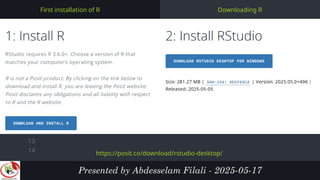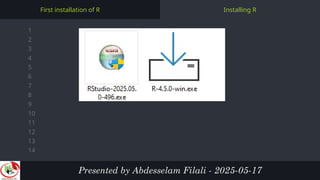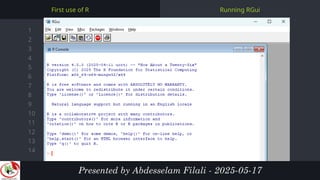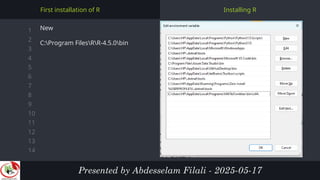R for Beginners with applications 1 R for Beginners with applications 1
- 1. R for Beginners with applications Lesson 1: Overview first installation of R basic operations from command line R Studio - Visual Studio Code First program Packages Write code from scratch and use basic packages in a clear & concise way, to do math and statistics analysis. From beginners to intermediate. Abdesselam Filali 2025-05-17 18h00 Algiers time
- 3. 1 2 3 4 5 6 7 8 9 10 11 12 13 14 Overview Overview of Rlang R is a programming language for statistical computing and data visualization. It has been adopted in the fields of data mining, bioinformatics and data analysis. Presented by Abdesselam Filali - 2025-05-17 Giorgi, Federico M.; Ceraolo, Carmine; Mercatelli, Daniele (27 April 2022). "The R Language : An Engine for Bioinformatics and Data Science". Life. 12 (5): 648. The core R language is augmented by a large number of extension packages, containing reusable code, documentation, and sample data. R software is open-source and free software. R is a GNU Project and licensed under the GNU General Public License.[3][10] It's written primarily in C, Fortran, and R itself. Precompiled executables are provided for various operating systems. As an interpreted language, R has a native command line interface. Moreover, multiple third- party graphical user interfaces are available, such as Rstudio and Visual Studio Code —an integrated development environment—, Jupyter—a notebook interface.
- 4. 1 2 3 4 5 6 7 8 9 10 11 12 13 14 History Overview of Rlang R was started by professors Ross Ihaka and Robert Gentleman as a programming language to teach introductory statistics at the University of Auckland. The language was inspired by the S programming language, with most S programs able to run unaltered in R. The language was also inspired by Scheme's lexical scoping (lisp). Presented by Abdesselam Filali - 2025-05-17 Ross Ihaka co-originator of R Robert Gentleman https://en.wikipedia.org/wiki/R_(programming_language)
- 5. 1 2 3 4 5 6 7 8 9 10 11 12 13 14 packages Overview of Rlang R packages are extensions to the R statistical programming language. R packages contain code, data, and documentation in a standardised collection format that can be installed by users of R, typically via a centralised software repository such as CRAN (the Comprehensive R Archive Network). The large number of packages available for R, and the ease of installing and using them, has been cited as a major factor driving the widespread adoption of the language in data science. Presented by Abdesselam Filali - 2025-05-17 https://en.wikipedia.org/wiki/R_package Base packages are immediately available when starting R and provide the necessary syntax and commands for programming, computing, graphics production, basic arithmetic, and statistical functionality.[ The Comprehensive R Archive Network (CRAN) was founded in 1997 by Kurt Hornik and Friedrich Leisch to host R's source code, executable files, documentation, and user-created packages.[21] Its name and scope mimic the Comprehensive TeX Archive Network
- 6. 1 2 3 4 5 6 7 8 9 10 11 12 13 14 Why use R ? Overview of Rlang • It is a great resource for data analysis, data visualization, data science and machine learning Presented by Abdesselam Filali - 2025-05-17 • It provides many statistical techniques (such as statistical tests, classification, clustering and data reduction) • It is easy to draw graphs in R, like pie charts, histograms, box plot, scatter plot, etc++ • It works on different platforms (Windows, Mac, Linux) • It is open-source and free • It has a large community support • It has many packages (libraries of functions) that can be used to solve different problems.
- 8. 1 2 3 4 5 6 7 8 9 10 11 12 13 14 Downloading R First installation of R Presented by Abdesselam Filali - 2025-05-17 https://posit.co/download/rstudio-desktop/
- 9. 1 2 3 4 5 6 7 8 9 10 11 12 13 14 Downloading R First installation of R Presented by Abdesselam Filali - 2025-05-17 Go to https://cran.rstudio.com/index.html download and install R
- 10. 1 2 3 4 5 6 7 8 9 10 11 12 13 14 Downloading R First installation of R Presented by Abdesselam Filali - 2025-05-17
- 11. 1 2 3 4 5 6 7 8 9 10 11 12 13 14 Installing R First installation of R Presented by Abdesselam Filali - 2025-05-17
- 12. 1 2 3 4 5 6 7 8 9 10 11 12 13 14 Installing R First installation of R Presented by Abdesselam Filali - 2025-05-17
- 13. 1 2 3 4 5 6 7 8 9 10 11 12 13 14 Installing R First installation of R Presented by Abdesselam Filali - 2025-05-17
- 14. 1 2 3 4 5 6 7 8 9 10 11 12 13 14 Installing R First installation of R Presented by Abdesselam Filali - 2025-05-17
- 15. 1 2 3 4 5 6 7 8 9 10 11 12 13 14 Installing R First installation of R Presented by Abdesselam Filali - 2025-05-17
- 16. 1 2 3 4 5 6 7 8 9 10 11 12 13 14 Installing R First installation of R Presented by Abdesselam Filali - 2025-05-17
- 17. 1 2 3 4 5 6 7 8 9 10 11 12 13 14 Running RGui First use of R Presented by Abdesselam Filali - 2025-05-17
- 18. 1 2 3 4 5 6 7 8 9 10 11 12 13 14 Installing R First installation of R Windows + X or left clic on the start button System Advanced system settings https://www.computerhope.com/issues/ch000549.htm Presented by Abdesselam Filali - 2025-05-17
- 19. 1 2 3 4 5 6 7 8 9 10 11 12 13 14 Installing R First installation of R Environment Variables Presented by Abdesselam Filali - 2025-05-17
- 20. 1 2 3 4 5 6 7 8 9 10 11 12 13 14 Installing R First installation of R Path Edit Presented by Abdesselam Filali - 2025-05-17
- 21. 1 2 3 4 5 6 7 8 9 10 11 12 13 14 Installing R First installation of R New C:Program FilesRR-4.5.0bin Presented by Abdesselam Filali - 2025-05-17
- 22. 3. basic operations from command line
- 23. 1 2 3 4 5 6 7 8 9 10 11 12 13 14 Running R in terminal First use of R Presented by Abdesselam Filali - 2025-05-17
- 24. 1 2 3 4 5 6 7 8 9 10 11 12 13 14 Installing R First installation of R Presented by Abdesselam Filali - 2025-05-17
- 25. 1 2 3 4 5 6 7 8 9 10 11 12 13 14 Installing R First installation of R Presented by Abdesselam Filali - 2025-05-17
- 26. 4. R Studio - Visual Studio Code
- 27. 1 2 3 4 5 6 7 8 9 10 11 12 13 14 Running RStudio First use of RStudio Presented by Abdesselam Filali - 2025-05-17
- 28. 1 2 3 4 5 6 7 8 9 10 11 12 13 14 Running RStudio First use of RStudio Presented by Abdesselam Filali - 2025-05-17
- 29. 1 2 3 4 5 6 7 8 9 10 11 12 13 14 Running RStudio First use of RStudio Presented by Abdesselam Filali - 2025-05-17
- 30. 5. first program
- 31. 1 2 3 4 5 6 7 8 9 10 11 12 13 14 Running RStudio First use of RStudio Presented by Abdesselam Filali - 2025-05-17
- 32. 1 2 3 4 5 6 7 8 9 10 11 12 13 14 Variable names First program Presented by Abdesselam Filali - 2025-05-17 A variable can have a short name (like x and y) or a more descriptive name (age, carname, total_volume). Rules for R variables are: • A variable name must start with a letter and can be a combination of letters, digits, period(.) and underscore(_). If it starts with period(.), it cannot be followed by a digit. • A variable name cannot start with a number or underscore (_) • Variable names are case-sensitive (age, Age and AGE are three different variables) • Reserved words cannot be used as variables (TRUE, FALSE, NULL, if...)
- 33. 1 2 3 4 5 6 7 8 9 10 11 12 13 14 Variable names First program Presented by Abdesselam Filali - 2025-05-17
- 34. 1 2 3 4 5 6 7 8 9 10 11 12 13 14 Variable names First program Presented by Abdesselam Filali - 2025-05-17 In R, variables do not need to be declared with any particular type, and can even change type after they have been set: R has a variety of data types and object classes. You will learn much more about these as you continue to get to know R.
- 35. 1 2 3 4 5 6 7 8 9 10 11 12 13 14 Basic data Types First program Presented by Abdesselam Filali - 2025-05-17 Basic data types in R can be divided into the following types: numeric - (10.5, 55, 787) integer - (1L, 55L, 100L, where the letter "L" declares this as an integer) complex - (9 + 3i, where "i" is the imaginary part) character (a.k.a. string) - ("k", "R is exciting", "FALSE", "11.5") logical (a.k.a. boolean) - (TRUE or FALSE) We can use the class() function to check the data type of a variable:
- 36. 1 2 3 4 5 6 7 8 9 10 11 12 13 14 Basic data Types First program Presented by Abdesselam Filali - 2025-05-17 There are three number types in R: - numeric - integer - complex Variables of number types are created when you assign a value to them.
- 37. 1 2 3 4 5 6 7 8 9 10 11 12 13 14 Basic data Types First program Presented by Abdesselam Filali - 2025-05-17 numeric A numeric data type is the most common type in R, and contains any number with or without a decimal, like: 10.5, 55, 787:
- 38. 1 2 3 4 5 6 7 8 9 10 11 12 13 14 Basic data Types First program Presented by Abdesselam Filali - 2025-05-17 integer Integers are numeric data without decimals. This is used when you are certain that you will never create a variable that should contain decimals. To create an integer variable, you must use the letter L after the integer value:
- 39. 1 2 3 4 5 6 7 8 9 10 11 12 13 14 Basic data Types First program Presented by Abdesselam Filali - 2025-05-17 Complex A complex number is written with an "i" as the imaginary part:
- 40. 1 2 3 4 5 6 7 8 9 10 11 12 13 14 Type conversion First program Presented by Abdesselam Filali - 2025-05-17 You can convert from one type to another with the following functions: as.numeric() as.integer() as.complex()
- 41. 1 2 3 4 5 6 7 8 9 10 11 12 13 14 Doing Math First program Presented by Abdesselam Filali - 2025-05-17 You can convert from one type to another with the following functions: as.numeric() as.integer() as.complex()
- 42. 1 2 3 4 5 6 7 8 9 10 11 12 13 14 operators First program Presented by Abdesselam Filali - 2025-05-17 R divides the operators in the following groups: Arithmetic operators Assignment operators Comparison operators Logical operators Miscellaneous operators
- 43. 1 2 3 4 5 6 7 8 9 10 11 12 13 14 Arethmetic operators First program Presented by Abdesselam Filali - 2025-05-17 Arithmetic operators are used with numeric values to perform common mathematical operations:
- 44. 1 2 3 4 5 6 7 8 9 10 11 12 13 14 Comparaison operators First program Presented by Abdesselam Filali - 2025-05-17 Comparison operators are used to compare two values:
- 45. 1 2 3 4 5 6 7 8 9 10 11 12 13 14 Logical operators First program Presented by Abdesselam Filali - 2025-05-17 Logical operators are used to combine conditional statements:
- 46. 1 2 3 4 5 6 7 8 9 10 11 12 13 14 Miscellaneous Operators First program Presented by Abdesselam Filali - 2025-05-17 Miscellaneous operators are used to manipulate data:
- 47. 5. packages
- 48. 48 Thank you for your attention
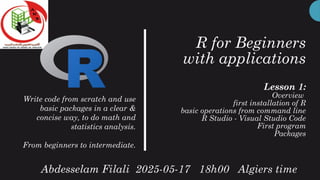

![1
2
3
4
5
6
7
8
9
10
11
12
13
14
Overview
Overview of Rlang
R is a programming language for statistical computing and data visualization. It has been
adopted in the fields of data mining, bioinformatics and data analysis.
Presented by Abdesselam Filali - 2025-05-17
Giorgi, Federico M.; Ceraolo, Carmine; Mercatelli, Daniele (27 April 2022). "The R Language
: An Engine for Bioinformatics and Data Science". Life. 12 (5): 648.
The core R language is augmented by a large number of extension packages, containing
reusable code, documentation, and sample data.
R software is open-source and free software. R is a GNU Project and licensed under the GNU
General Public License.[3][10] It's written primarily in C, Fortran, and R itself. Precompiled
executables are provided for various operating systems.
As an interpreted language, R has a native command line interface. Moreover, multiple third-
party graphical user interfaces are available, such as Rstudio and Visual Studio Code —an
integrated development environment—, Jupyter—a notebook interface.](https://image.slidesharecdn.com/rforbeginnerswithapplications1-250531092308-8d63c8b0/85/R-for-Beginners-with-applications-1-R-for-Beginners-with-applications-1-3-320.jpg)

![1
2
3
4
5
6
7
8
9
10
11
12
13
14
packages
Overview of Rlang
R packages are extensions to the R statistical programming language. R packages contain
code, data, and documentation in a standardised collection format that can be installed by
users of R, typically via a centralised software repository such as CRAN (the Comprehensive
R Archive Network). The large number of packages available for R, and the ease of
installing and using them, has been cited as a major factor driving the widespread
adoption of the language in data science.
Presented by Abdesselam Filali - 2025-05-17
https://en.wikipedia.org/wiki/R_package
Base packages are immediately available when starting R and provide the necessary syntax
and commands for programming, computing, graphics production, basic arithmetic, and
statistical functionality.[
The Comprehensive R Archive Network (CRAN) was founded in 1997 by Kurt Hornik and
Friedrich Leisch to host R's source code, executable files, documentation, and user-created
packages.[21] Its name and scope mimic the Comprehensive TeX Archive Network](https://image.slidesharecdn.com/rforbeginnerswithapplications1-250531092308-8d63c8b0/85/R-for-Beginners-with-applications-1-R-for-Beginners-with-applications-1-5-320.jpg)


